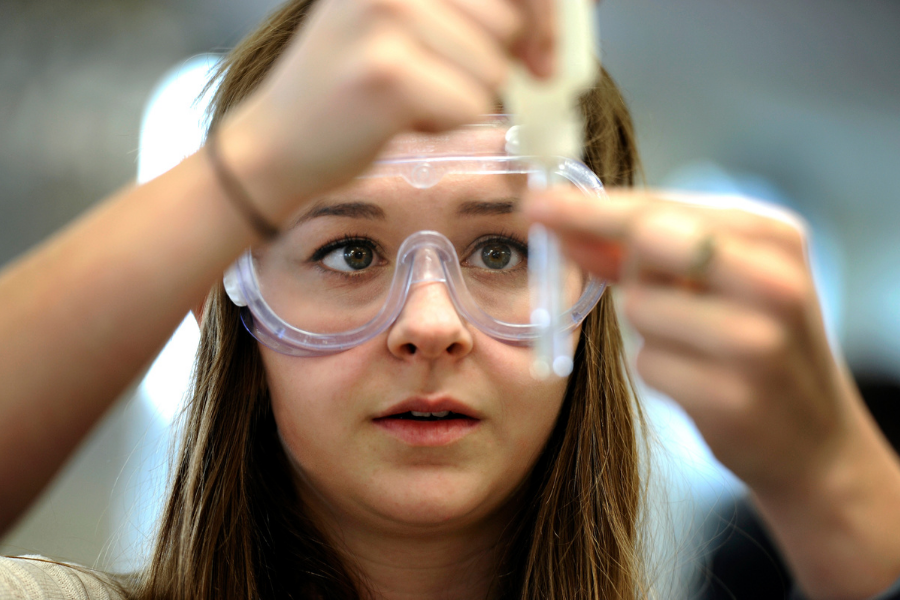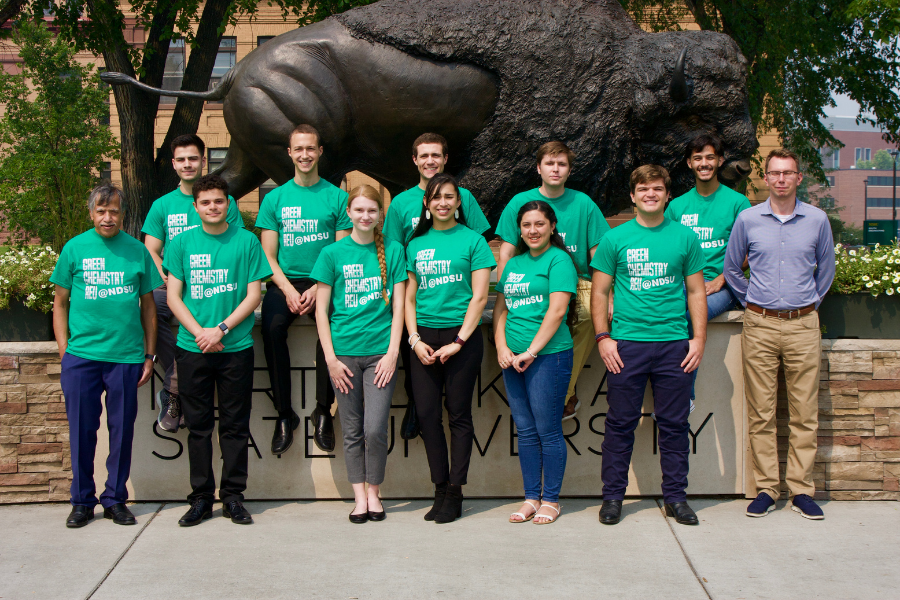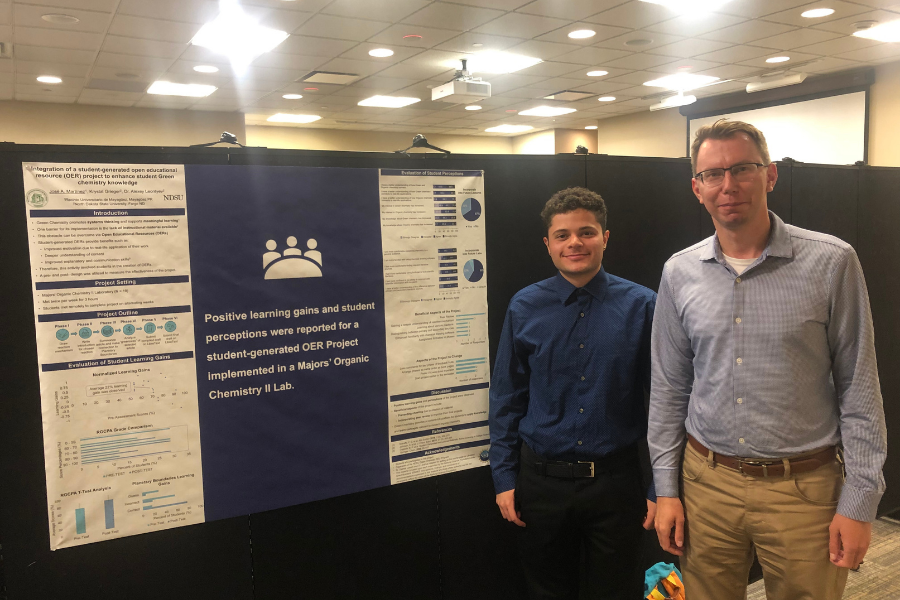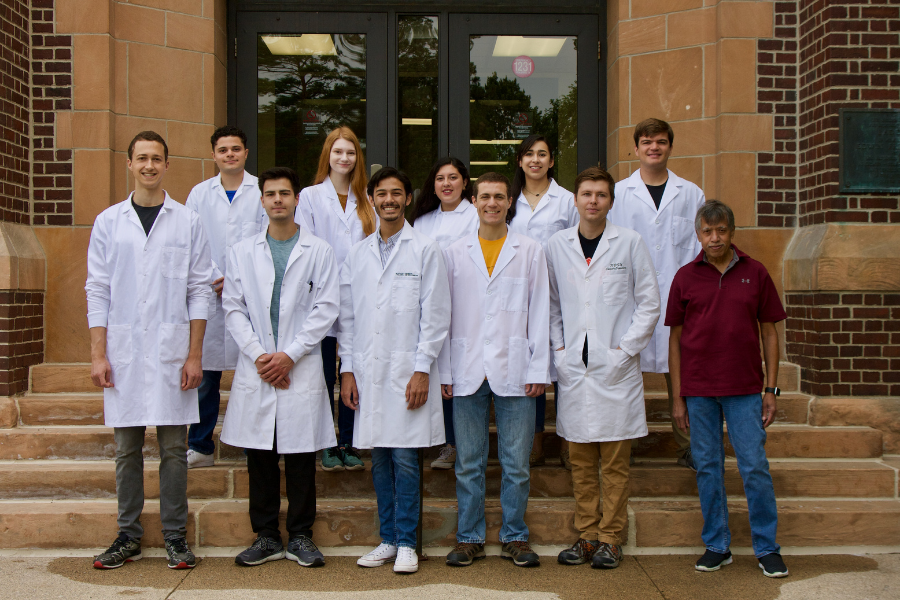About the Program
The Departments of Chemistry and Biochemistry and Coatings and Polymeric Materials at North Dakota State University will host 10 undergraduate students in an interdisciplinary summer research program focused on Green Chemistry.
Each REU student will work with individual Research Mentor over the course of 10 weeks, maximizing one-on-one mentoring experience. In addition to the research activities, students are expected to attend workshops on conducting research and professional development sessions.
The program begins late May and runs through early August.
If you have any questions about the program, contact Mukund Sibi or Alexey Leontyev.


Who should apply
Undergraduate students interested in research opportunities in Green Chemistry.
We especially encourage students from underrepresented groups and non-ACS accredited programs to apply.

Eligibility
Participation in the Green Chemistry at NDSU REU program is limited to students who meet the following criteria:
- U.S. Citizen or Permanent Resident
- Current undergraduate credential with at least one semester of coursework remaining before obtaining a bachelor's degree

How to apply
- Fill out an application form.
- Two reference letters should be sent to Anna Adkins.
Before filing out an application form, students who are interested should familiarize themselves with potential projects and faculty mentors by checking out the research abstracts at the bottom of the page.
The applications deadline is January 31, 2023.
Program details
- $5000 stipend for successfully completing 10-week program
- Room and board on NDSU campus
- Unique research and professional development opportunities
- Cohort building activities and networking

This material is based upon work supported by the National Science Foundation under Grant Numbers 2050802. Any opinions, findings, and conclusions or recommendations expressed in this material are those of the author(s) and do not necessarily reflect the views of the National Science Foundation.
About Fargo
NDSU is located in Fargo, rated as one of the best places to live in the U.S.
Descriptions of Projects
Oxygen Diffusion Through Biobased Films (Faculty Mentor: Alex Parent)
The Parent group focuses on developing catalysts for renewable oxidation chemistry. One application of our research is the design of improved catalysts for forming biobased films and coatings. These coatings are made from feedstocks known as drying oils, which include flaxseed oil, soybean oil, and hempseed oil. In order to understand how catalysts interact with oxygen gas to form these coatings, it is important to know how oxygen gas diffuses through these films as they form. During this REU project, you will study the diffusion of oxygen through films at different stages of oxidation. You will learn techniques for monitoring and controlling gas flow, and gain experience using several gas detection methods. You will also have the opportunity to learn techniques for characterizing biobased films in terms of both chemical and physical properties.
Multi-enzyme Immobilization on Metal-Organic Materials for Boosting the Catalytic Efficiency of Redox Enzymes (Faculty Mentor: Zhongyu Yang)
Enzyme immobilization in MOFs (metal–organic frameworks) offer enhanced enzyme reusability and sustainability, protection, and substrate diffusivity. In certain cases, MOF scaffolds even improves the catalytic efficiency of enzymes by offering unique metal centers, specific microenvironments in the pores, and/or special chemical/physical properties of ligands. The enzymes and substrates, however, often have to be smaller than MOF pores, usually a few nm, limiting the broad application of MOFs as enzyme hosting platform. Our group is developing new MOF based enzyme immobilization approaches to remove this limitation and boosting enzyme catalytic efficiency via unique ligand design and selection. Of particular interest is MOF scaffold that can absorb visible light and utilize the sun light to promote electron transfer in redox enzymes. This will potentially help northern states to produce O2 in the long winter.
In this REU project, the undergraduate students will 1) identify proper ligands that can absorb visible lights to generate high energy active electrons, 2) demonstrate the use of electrons to promote the functionality of redox enzymes encapsulated in the MOF scaffold, and 3) apply the developed biocatalysts on CO2 conversion and O2 generation that mimic the photosynthesis process in nature. Overall, this project will produce sustainable biocomposites, or green biocatalysts that can convert CO2 into glucose in order to reduce the global warming. This is especially important for ND due to our long but sunny winters where there are almost no leaves can carry out photosynthesis.
Application of Machine Learning, Cheminformatics and Computational Chemistry in Materials Research (Faculty Mentor: Bakhtiyor Rasulev)
The research in Rasulev group is focused on application of Machine Learning, Cheminformatics and Computational Chemistry methods in characterization and design of novel materials, including bio-based polymeric materials and nanomaterials. The group applies experimental data, computation, data analysis and predictive structure-property relationship modeling to predict various materials properties, including solubility, degradation rate, toxicity, etc. REU students will learn how to design new materials, computationally characterize materials, predict properties, extract chemical data from available public sources, develop datasets with structures and their properties, apply machine learning and cheminformatics tools.
Biobased Grafted Copolymers for Food Packaging Paper Modification (Faculty Mentor: Andriy Voronov)
During internship in Voronov’s group, students will have an opportunity to work on synthesis, characterization and testing of biobased polymeric materials for food packaging paper modification. Combining acrylic plant oil-based monomers derived from various plant/vegetable oils with hemicelluloses from different plant sources, the students will learn how to: carry out synthesis of grafted copolymers via free radical polymerization mechanism; characterize and control physico-chemical properties of the resulted product (“grafted hemicelluloses”); test thermomechanical performance of free films obtained from synthesized materials; apply the synthesized grafted hemicelluloses as coatings/adhesives onto various paper substrates (including commercial samples); evaluate barrier and protective potential of the modified paper.
Assessment of Students' Knowledge of Green Chemistry (Faculty Mentor: Alexey Leontyev)
As implementation of green chemistry into university-level courses increases, it is becoming increasingly important that educators have tools to measure student knowledge of green chemistry principles. We are investigating two different approaches to capture changes in students’ knowledge – using selected-response and constructed-response questions. For the selected-response approach, we designed the Assessment of Student Knowledge of Green Chemistry Principles (ASK-GCP) instrument. We are evaluating its sensitivity and effectiveness for measuring student knowledge of green chemistry in various settings.
However, one of the disadvantages of selected-response questions is their limited ability to provide insights into student misconceptions and reasoning. We utilized constructed-response case comparison prompts to address this problem and elicit their reasoning about green chemistry. We incorporated a series of two-reaction case comparison prompts within organic chemistry lecture and laboratory courses to evaluate student knowledge and application of the green chemistry principles. In these prompts, two reaction alternatives were presented, and students were asked to identify which of two reactions would be the “greener” option and explain their reasoning.
This project involves the analysis of data from both methods.
Green Catalysis for Materials and Medicine (Faculty Mentor: Gregory Cook)
Our group is exploring sustainable methods for the in situ generation and application of new catalysts to affect coupling reactions that are critical for the synthesis of monomers for new materials and scaffolds for medicinal chemistry applications. We have developed a new method for the facile generation of pi-allylpalladium chloride complexes directly from palladium dichloride and terminal olefins. These have been applied to a variety of allylation and cross coupling reactions for the functionalization of heterocyles. In addition, we have discovered new C-H amidation reactions of indoles using earth abundant nickel catalysts. Students working on this project will learn fundamentals of catalytic organometallic chemistry as well as aspects of sustainability in catalyst design and application. Students will learn to characterize organic compounds using IR and NMR spectroscopy and mass spectrometry
Modeling of Quantum Dots for Photo-Catalysis of Biomass Valorization (Faculty Mentor: Svetlana Kilina)
Catalytic valorization of lignin, which is potentially the largest source of renewable aromatics, represents the most attractive but challenging topic in biomass conversion. It was recently shown that CdS Quantum Dots (QD) efficiently catalyze the selective cleavage of β-O-4 bonds, the most abundant linkage in lignin through photo-redox mechanism based on a Cα radical intermediate. However, mechanism of controlling this reaction via QD engineering is unclear. In our group, we will use quantum chemistry calculations to provide important insights into mechanisms of this photo-driven reaction and the effect of the QD composition, size, and surface ligands on the photocatalytic properties governing such mechanisms. The REU students will be trained in quantum chemistry calculations of nanostructures with complicated surface chemistry and interfaces. By the end of this research experience, students will learn how to
• use Unix operation system and run calculations at HPC clusters
• use common quantum chemistry software, such as Gaussian-16
• construct geometries and analyze calculated data
• model optical properties of nanostructures
• understand the main concepts and principles of molecular design
• perform computational studies in a tight collaboration with experimentalists
Structure-Property Relationship of Biobased Materials (Faculty Mentor: Mohi Quadir)
Quadir group is involved in discovering new routes to sustainable nanotechnology for biomedical applications. The part of our REU project involves integration of ideas for colloid chemistry, supramolecular chemistry, and biology. By inspiring innovative thinking, we will encourage students to participate in laboratory-based projects in colloid and surface science and learn how to apply these ideas in solving biological problems. Using polyols of sucrose soyate (1), we have established a green and sustainable route to fabricate nanoparticles, termed as or ‘soysomes’. The REU student in our lab will be involved four specific activities: (a) identifying the phase behavior of soysomes (b) evaluating encapsulation of drug molecules inside soysomes, and (c) observing assembly and packing behavior of the soysomes under microscope, and (d) understanding how mammalian cells interact with soysomes.
Green Synthesis of Monomers from Biomass (Faculty Mentor: Mukund Sibi)
Research projects in the Sibi group involve the development of green methods for the synthesis of monomers from biomass. A key feedstock material we have used extensively is 5- hydroxymethylfurfural (HMF), which is readily available from cellulose. The REU students will be trained in state-of-the art organic synthesis with a significant emphasis on green principles and will be involved in the conversion of HMF and derivatives to amines and alcohols, key components of Non Isocyanate Polyurethanes.
Synthesis and Characterization of Polymers from biomass (Faculty Mentor: Dean Webster)
The Webster group studies polymers made from biomass and their use in applications such as coatings, composites, 3D printing, and foams. A specific focus is on crosslinked polymers, also known as thermosets. A thermosetting polymer system usually involves the preparation of a material that has chemically reactive groups and then when a curing agent is added, a crosslinked polymer is formed. We work with a number of base materials such as vegetable oils, lignin, and cellulose- derived chemicals. Our studies involve the preparation of materials having changing compositions and then an assessment of their properties. We evaluate properties such as strength, stiffness, and hardness and specialized tests depending on the use of the material. We also use advanced methods to determine thermal and dynamic mechanical properties of the materials.


